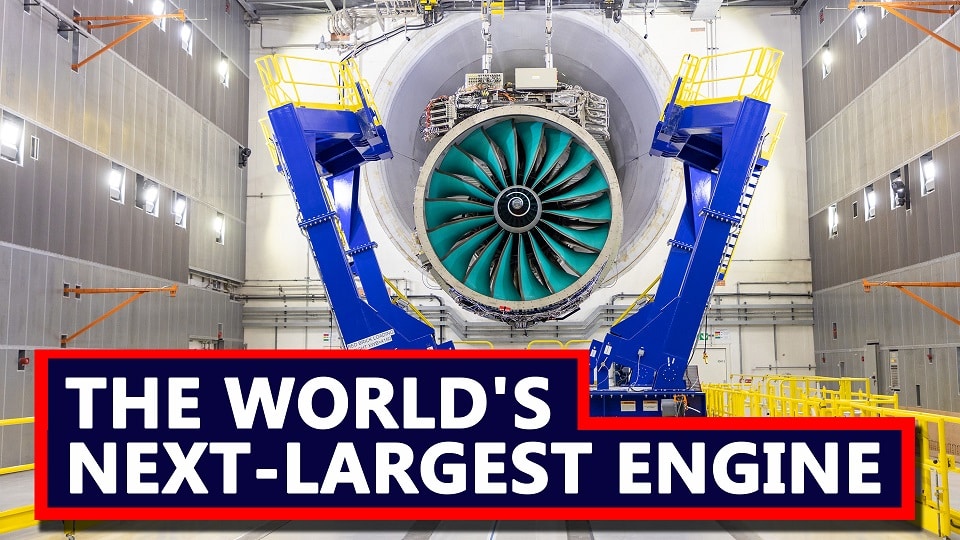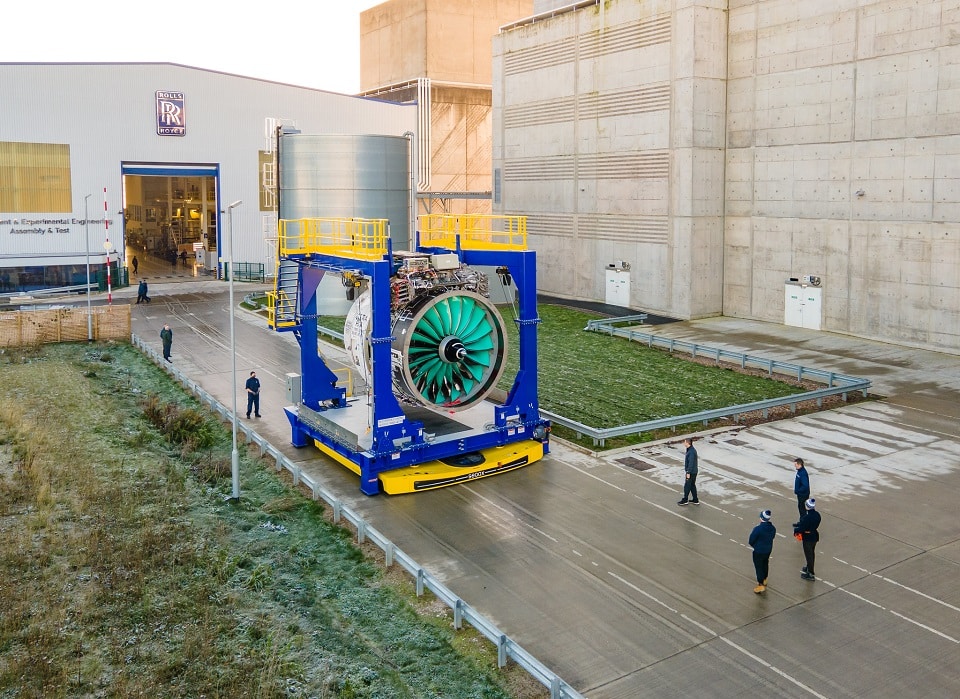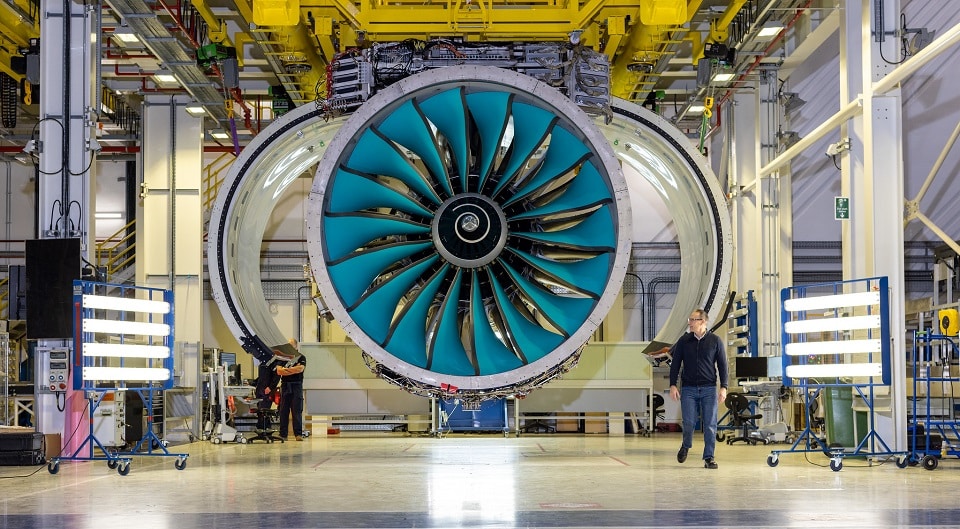Aerospace
The world’s largest engine The Rolls Royce UltraFan: 10 Key Takeaways.

Any aircraft’s basic component, on which its capacity and speed are largely dependent, is its engine. However, recently, the majority of aircraft companies have come under fire for significantly contributing to air pollution in the environment, which causes global warming and other problems.
As a result, companies like General Electric, Rolls Royce, Pratt & Whitney, and others are currently working on developing new types of engines that may both cut carbon emissions and improve operator productivity.
Airlines are concentrating more on sustainable fuel in the near future because it will be the only source that can replace the crude oils that come from the earth’s core and might potentially affect both the environment and our planet.
Therefore, aerospace companies are working to construct engines using 100 SAF fuel, which can be produced naturally in the environment and also causes less harm to the environment.
Rolls Royce in talks with DRDO to rev up AMCA engines(Opens in a new browser tab)
The first prototype of the UltraFan engine, which will be used in future aircraft, was completed by Rolls Royce in December. This engine’s innovation will undoubtedly aid in the achievement of net zero emissions for the environment and the aviation sector. We’ll look at a few fascinating facts about it in this article.
1. The biggest engine in the world
It is the biggest aviation engine Rolls Royce has ever produced, with a fan diameter of about 140 inches. This makes it bigger than the G9x engine, which is now mounted in the Boeing 777x and has a size of 134 inches.
The GE 9x engine has a thrust of roughly 490 kN, whereas this engine can generate 444.82 kN of thrust.
[adinserter block="3"]
2.100% SAF-compatible engine
Additionally, the Rolls-Royce engine is compatible with 100% Sustainable Aviation Fuel, which will be used in the demonstrator’s first test early this year. Rolls Royce has also created engines for Gulfstream aircraft, which are currently also SAF-compatible. In addition, Rolls-Royce is intensively looking into hydrogen and hybrid electric power possibilities.
3. Fan constructed with hollow titanium blades.
Rolls-Royce fan blades are constructed from a unique composite material. Rolls-Royce will switch to carbon composite fan blades from its customary hollow titanium blades, which will result in a 340 kg (750 lb) weight reduction per engine. And because these blades operate at a low speed, they are unique.
[adinserter block="13"]
4. A thrust reverser is not required for this engine.
This engine’s dual engine layout leads to a geared turbofan with a variable pitch fan system that promises an improvement in fuel burn of at least 25%. An overall pressure ratio of 70:1 and a bypass ratio of 15:1 are the goals of the geared/variable pitch UltraFan.
The Advance core is retained in the Ultrafan, which additionally features a geared turbofan architecture with variable-pitch fan blades. The fan won’t require a thrust reverser because it will adjust pitch to be most effective for each flying phase.
5. Low-pressure ratio fan operability will be facilitated by the variable pitch fan.
The initial test gear’s ratio will be close to 4:1, and its thrust could reach 440 kN. (100,000 lbf). Variable-pitch blades rather than a variable area jet nozzle are used to treat low-speed fan instability caused by higher bypass and a lower fan pressure ratio. Moreover, get rid of the thrust reverser.
6. the working of a rolls Royce ultra fan.
After the power gearbox, which generates secondary power thrust in a high-speed engine, the next section is the Advanced Core system, where compressed air will be generated, followed by lean burn combustion, and the last section is a High-Speed multi-stage IP turbine system.
The front fan operates at a low speed and is made of composite material. In comparison to Trent’s first generation, UltraFan is 25% more efficient, produces 40% less NOx, 35% less noise, and nearly no nvPM particles during cruising.
[adinserter block="1"]
7. Are Rolls Royce and the GE 9x engine in competition?
This engine competes quite well with the GE9x engine, which has a similar engine but a somewhat higher thrust and speed ratio. The GE 9x engine was launched and is specifically intended for the Boeing 777x, but in the future, the RR engine might be one of the options for that engine.
However, we can’t say with certainty that this engine will also be installed in the Boeing 777x until we get more information. but I’m still unsure of it.
8. Rolls Royce constructed a unique engine test bed for €84 million ($94 million).
This engine needed a proper test bed and rolls to be tested. In order to understand how an engine behaves in various types of weather environments and tough foreign particulate inject testing, Rolls Royce is already preparing for testing in February 2023. In addition, the engine will undergo standby time testing, which could be crucial for any engine manufacturer.
The company built The cost of the specially built test equipment is €84 million ($94 million). Rolls-Royce has constructed a power rig near Dahlewitz, close to Berlin, with a capacity of 15–80 MW (20,000–107,000 hp) gear sets, simulating loading circumstances in flight;
9. UltraFan’s scalable technology
The engine will be employed in the upcoming aircraft, providing safe operations and 100% utilization of SAF fuel. increased efficiency and lower carbon emissions for airplanes let airlines increase their profits. UltraFan’s scalable technology from ~25,000-110,000lb thrust delivers the potential to further improve the fuel efficiency of both narrowbody and widebody aircraft by up to 10 percent.
[adinserter block="2"]
10. UK and EU technology collaboration
In the nearer term, there are options to transfer technologies from the UltraFan development program to current Trent engines to deliver enhanced fuel efficiency and reductions in emissions. The UltraFan technology demonstrator program has been supported by the UK’s Aerospace Technology Institute and Innovate UK, the EU’s Clean Sky programs plus LuFo and the State of Brandenburg in Germany.
Read more: Click here

Aerospace
Boeing Transfers Rocket Stage to NASA, Paving Way for Human Moon Mission

Boeing has achieved a significant milestone by providing NASA with the second core stage of the Space Launch System (SLS) rocket.
This crucial component, crafted at NASA’s Michoud Assembly Facility (MAF), is set to propel the Artemis II crew into lunar orbit, marking humanity’s return to deep space after a 50-year hiatus.
The monumental Boeing-built rocket stage, the largest element of the Artemis II mission, will embark on a journey aboard the Pegasus barge, traveling 900 miles to NASA’s Kennedy Space Center.
Comparison of two legendary aircraft B777x vs B747 aircraft:Click here
Upon arrival, it will be meticulously integrated with other essential Artemis II components, including the upper stage, solid rocket boosters, and NASA’s Orion spacecraft within the iconic Vehicle Assembly Building. This intricate integration process is a vital step toward the eagerly anticipated Artemis II launch, slated for 2025.
“Boeing-built products helped land humankind on the moon in 1969, and we’re proud to continue that legacy through the Artemis generation,” remarked Dave Dutcher, vice president and program manager for Boeing’s SLS program. “Together, with NASA and our industry partners and suppliers, we are building the world’s most capable rocket and paving the way to deep space through America’s rocket factory in New Orleans.”
NASA, Lockheed Martin Reveal X-59 Quiet Supersonic Aircraft:Click here
The delivery of Core Stage 2 marks a significant achievement in the evolution of the SLS rocket. Towering over 200 feet and powered by four RS-25 engines, this core stage, coupled with two solid-fueled booster rockets, will generate a staggering 8.8 million pounds of thrust. This immense power is crucial to launching Artemis II and future missions into the vast expanse of space.
The SLS rocket stands unparalleled in its capability to transport both crew and substantial cargo to the moon and beyond in a single launch. Its extraordinary capacity will facilitate the delivery of human-rated spacecraft, habitats, and scientific missions to destinations including the moon and Mars, ushering in a new era of space exploration.
-

 Travel1 week ago
Travel1 week agoAir India to Expand US Operations with Three New Routes After a Decade
-

 Travel2 weeks ago
Travel2 weeks agoWhy We Should Avoid These Stamps in a Passport
-

 Airlines1 month ago
Airlines1 month agoInvestigations Reveal Fake Chinese Titanium in Boeing and Airbus Jets
-

 Tech4 weeks ago
Tech4 weeks agoChina’s CATL Plans 1,800-Mile Electric Plane Launch by 2027
-

 Airport3 days ago
Airport3 days agoTop 10 Largest Airports in the World by Size
-

 Aerospace4 weeks ago
Aerospace4 weeks agoChina’s Fighter Jets Turn Wings into Autonomous Drones
-

 Airlines4 days ago
Airlines4 days agoAir India Rolls Out A350s for Delhi-New York JFK and Newark Routes
-

 Defence3 weeks ago
Defence3 weeks agoBoeing Enhances Chinook with New Engines and Block II Upgrades at $96 Million









